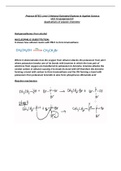Essay
BTEC Applied Science Unit 14D
- Course
- Institution
D.P5 D.M5 D. D4 Criteria's met. Achieved Distinction first time. This assignment covers all areas and criterias to gain a Distinction in this Assignment and the whole unit 14. Cheapest price right Now!!!.
[Show more]



